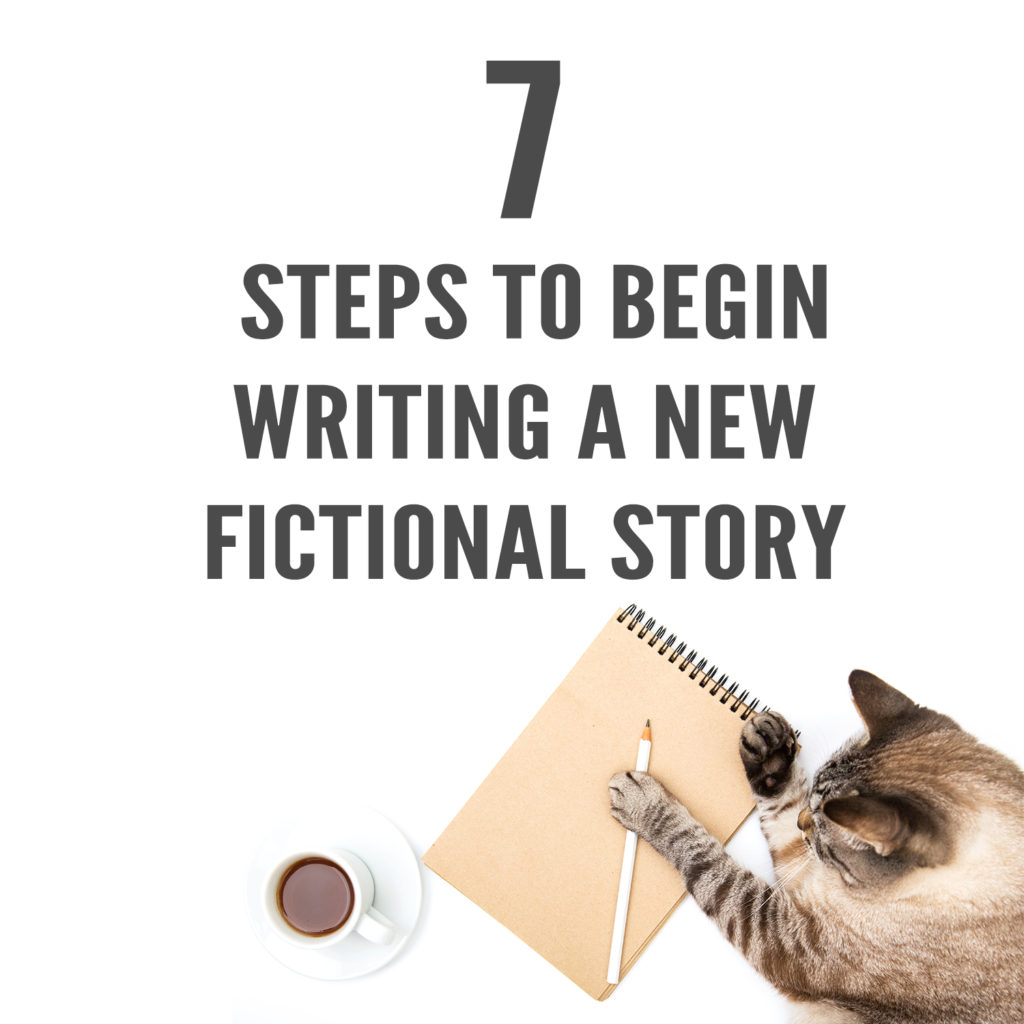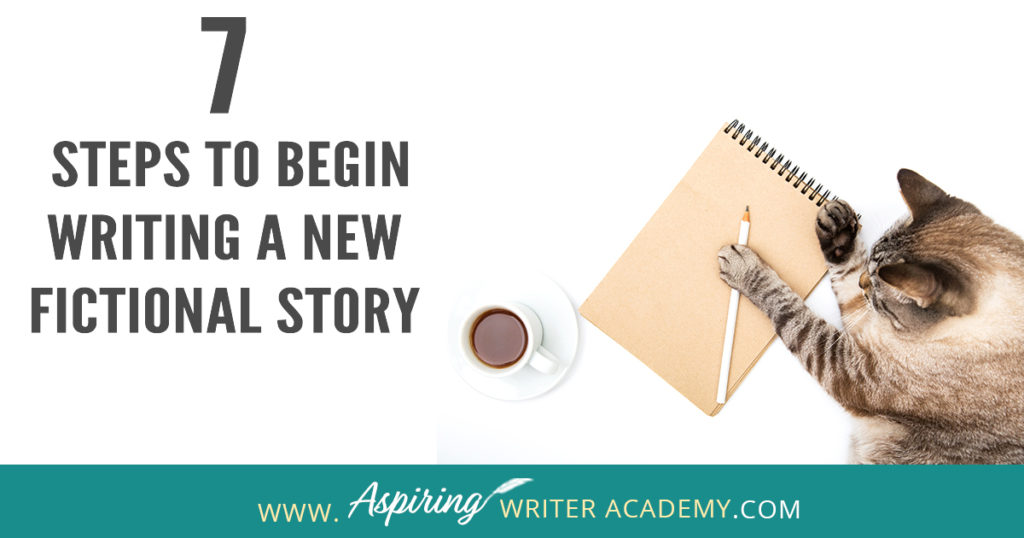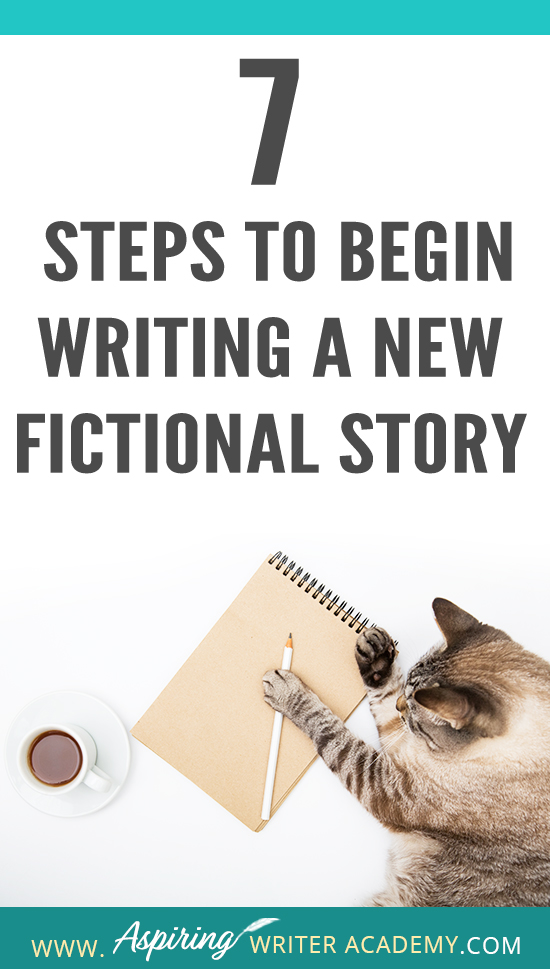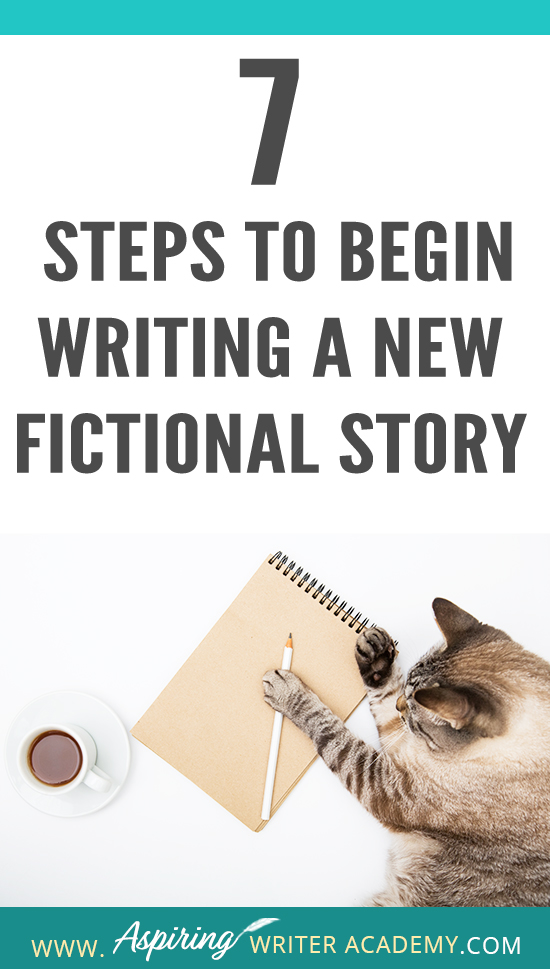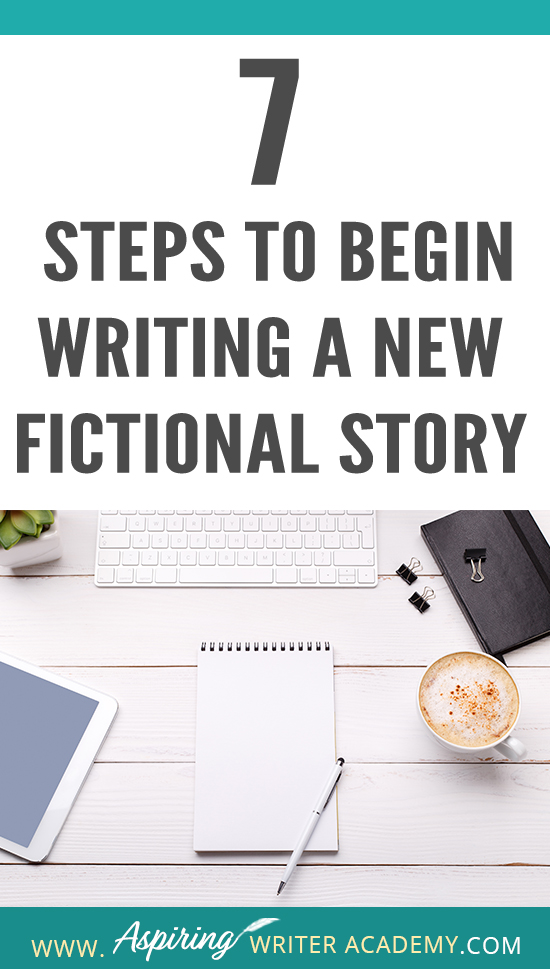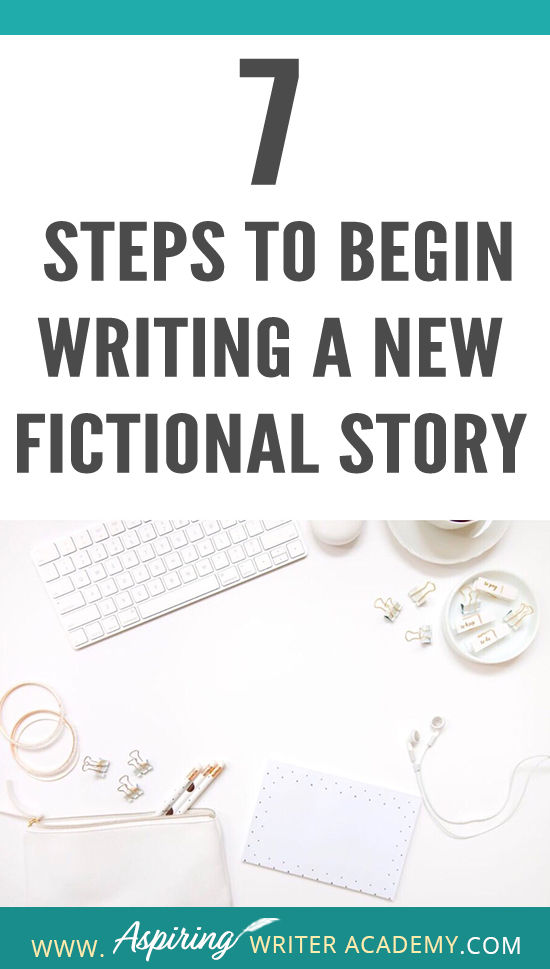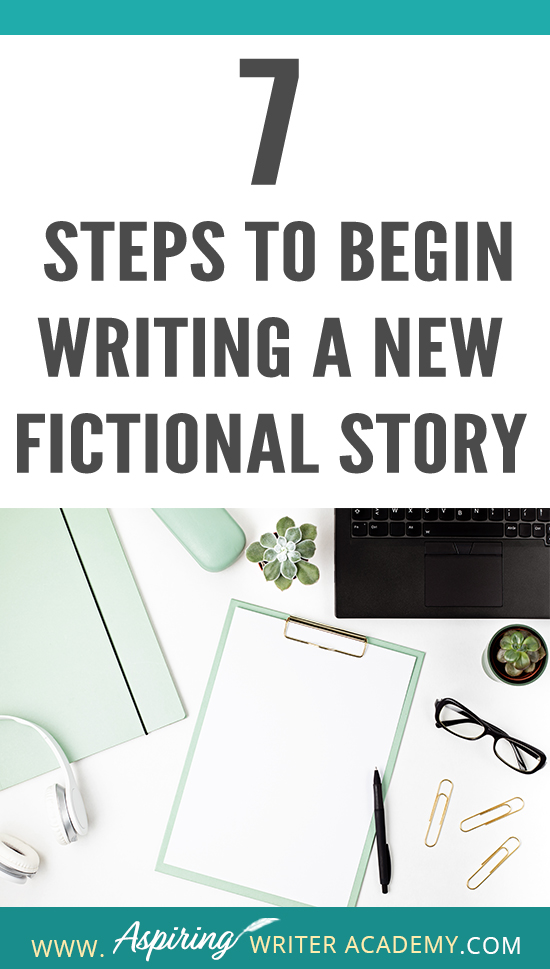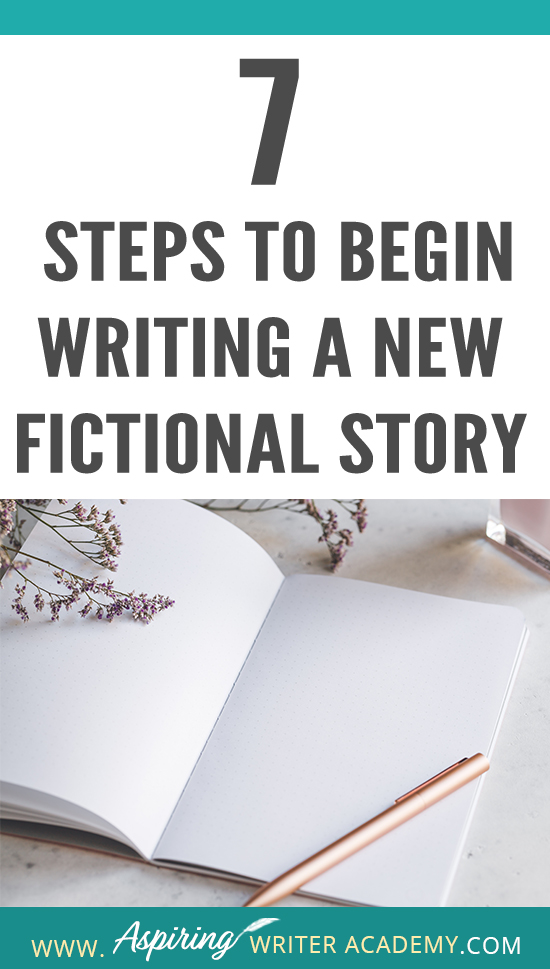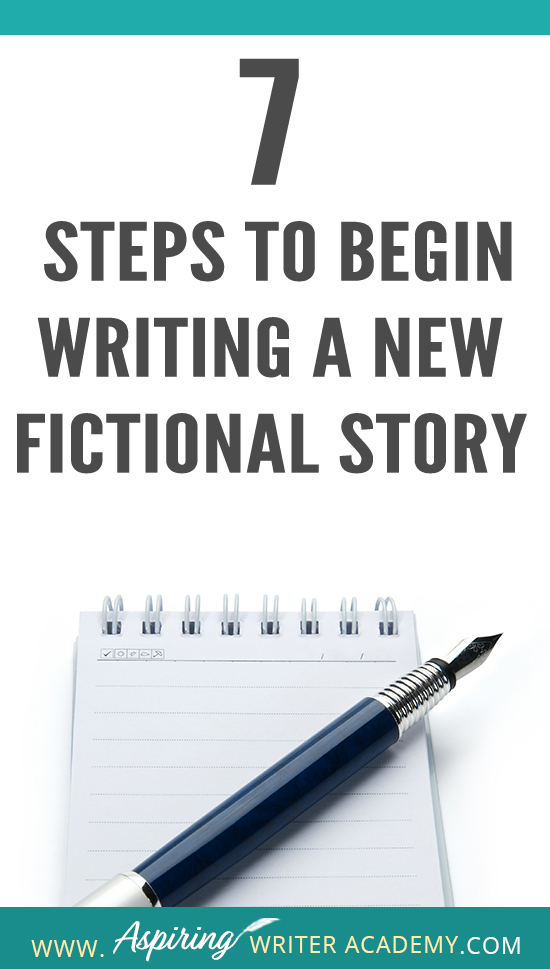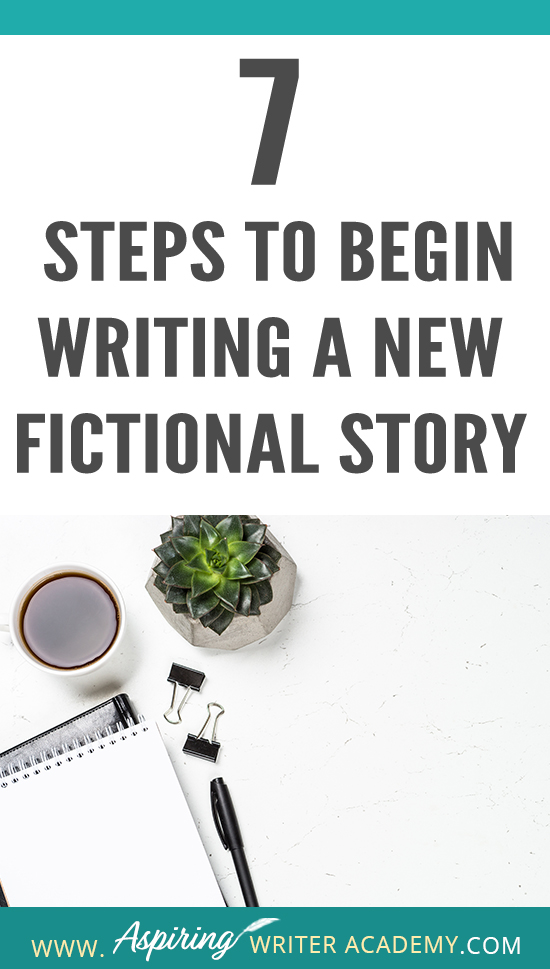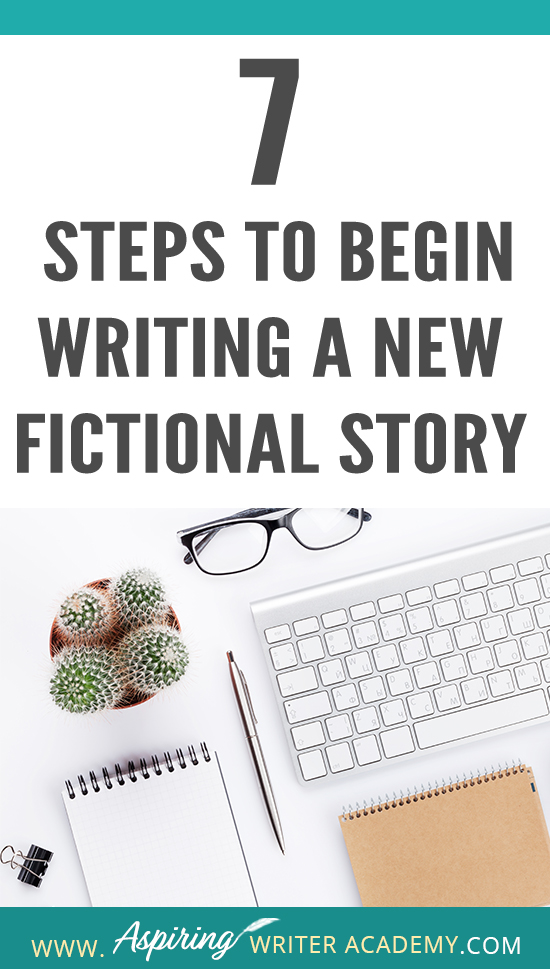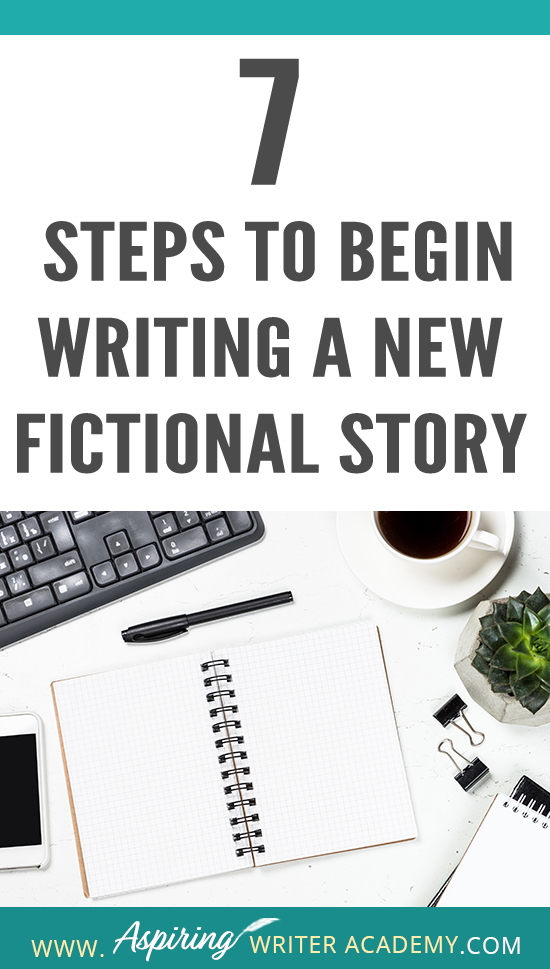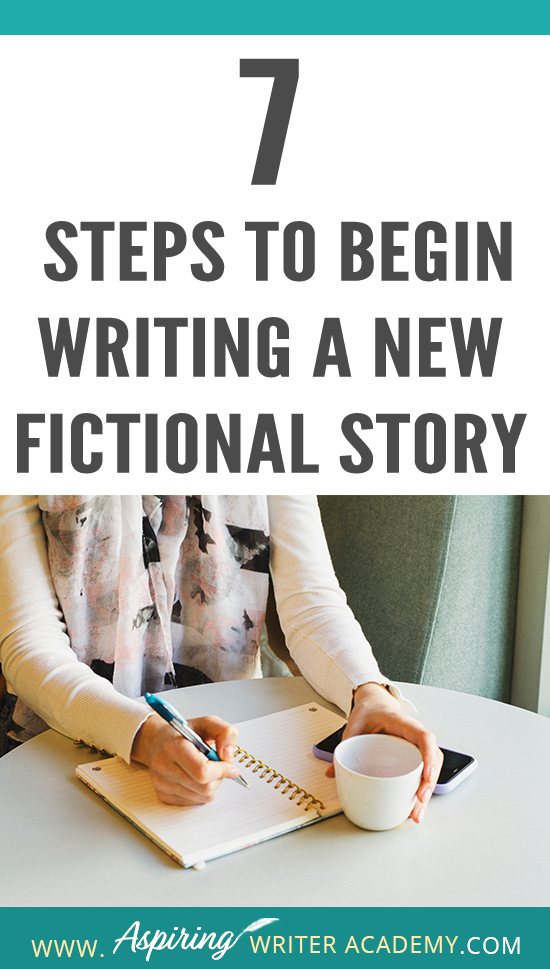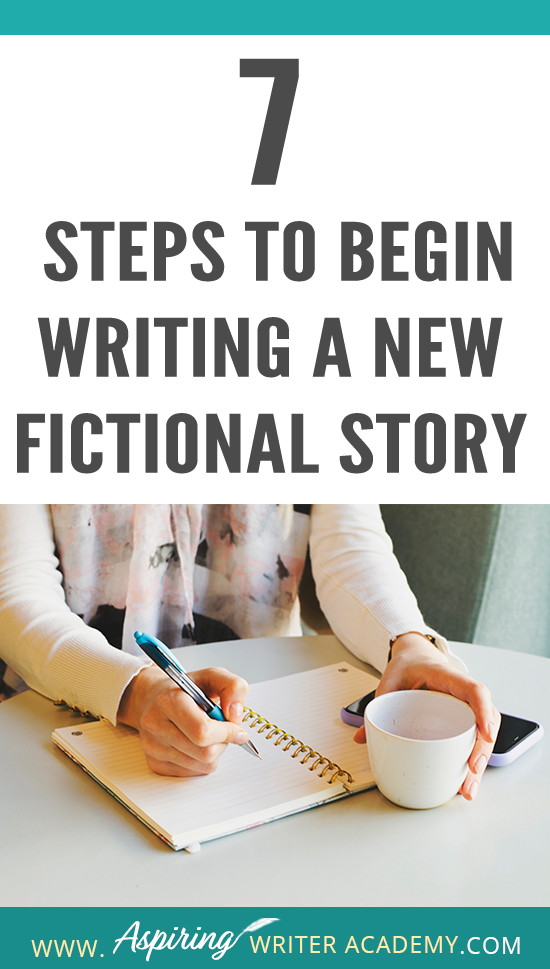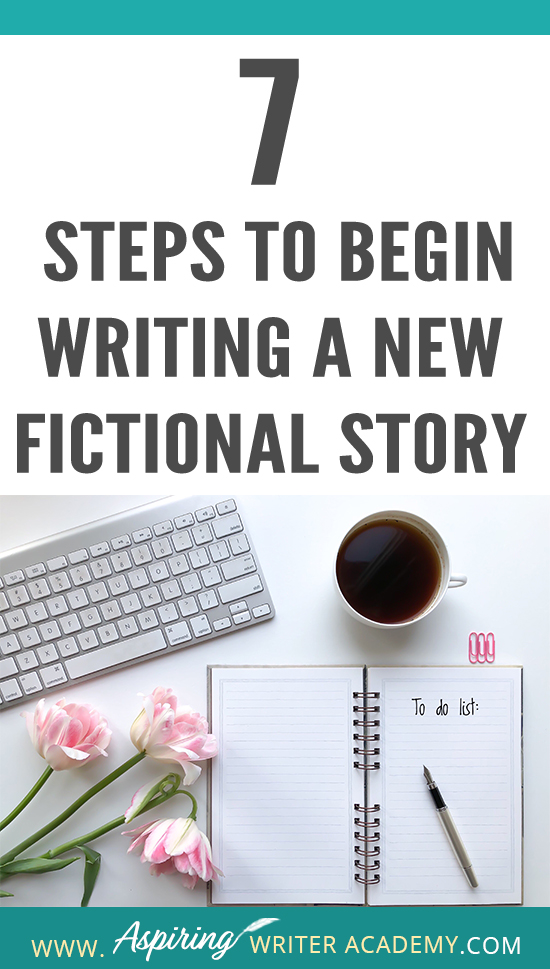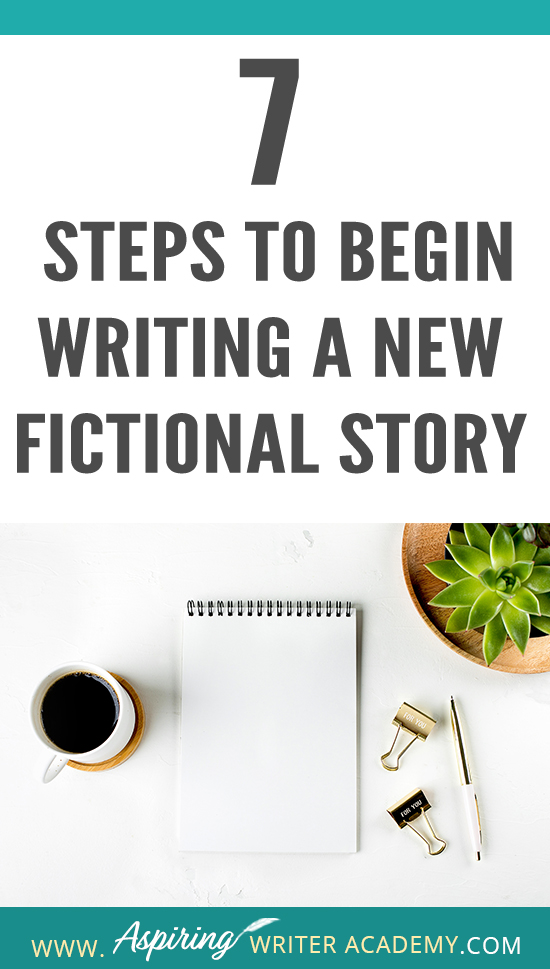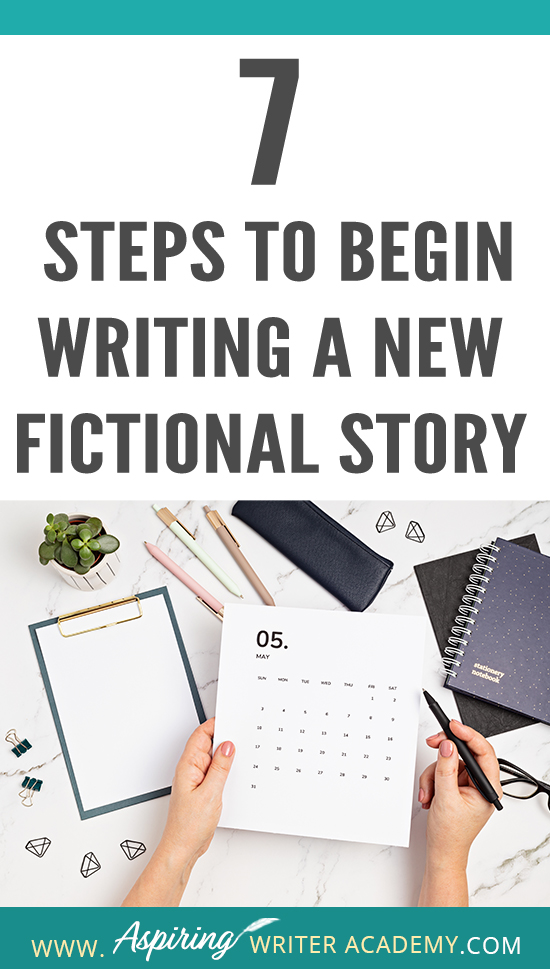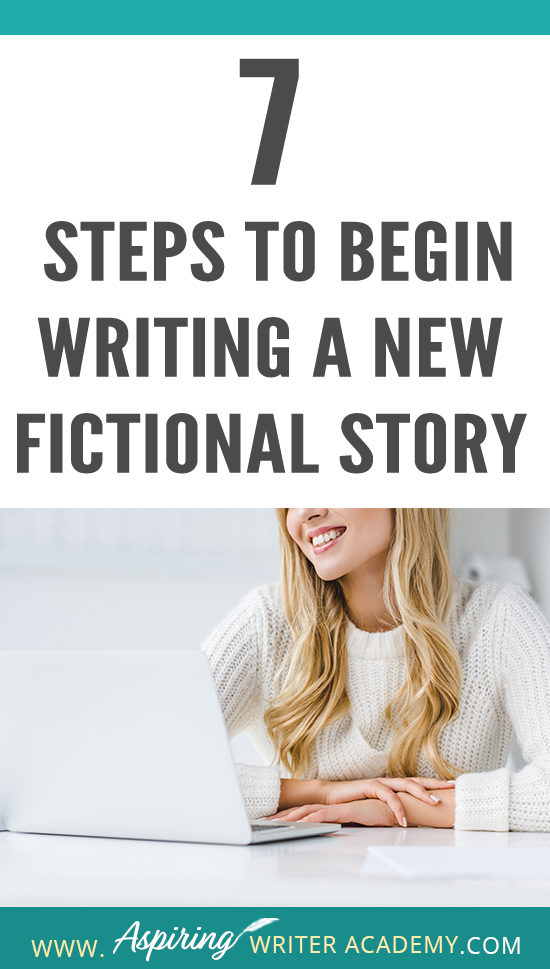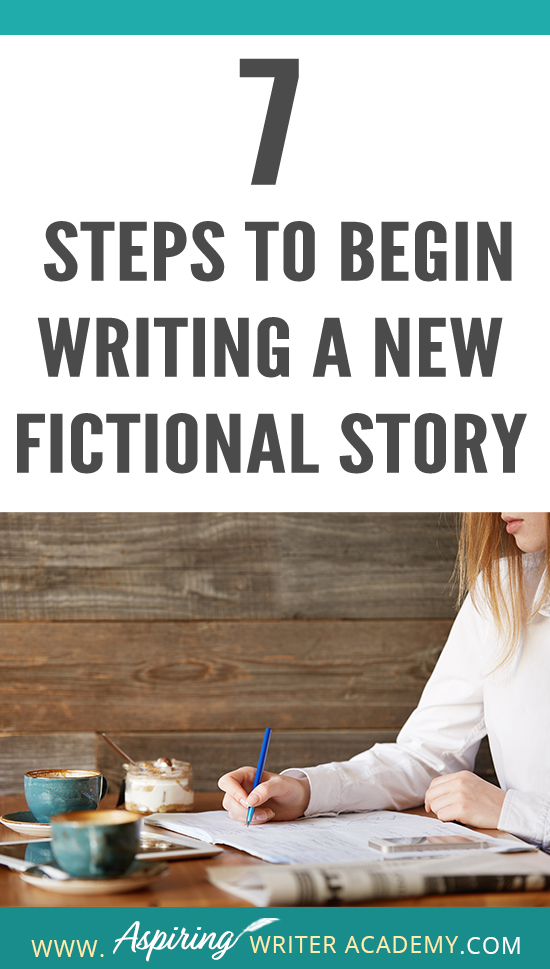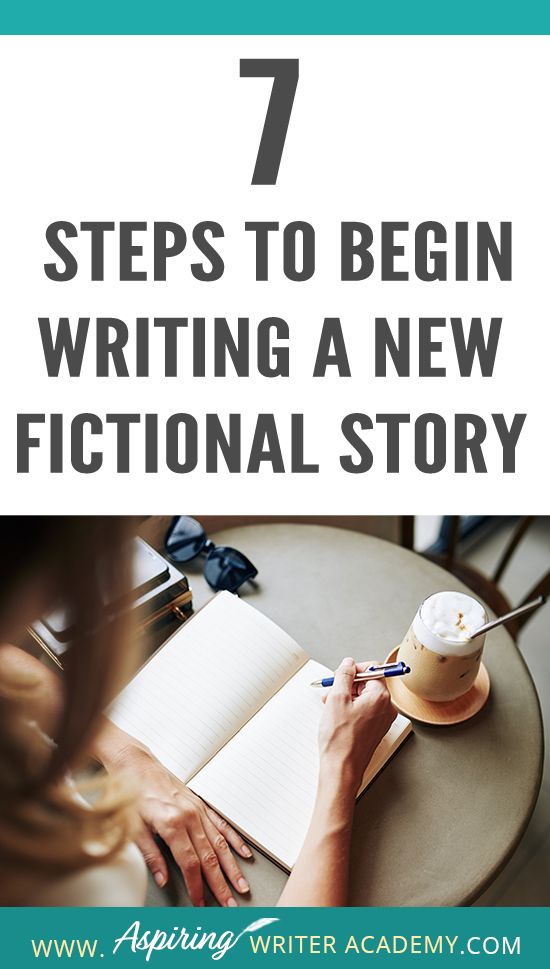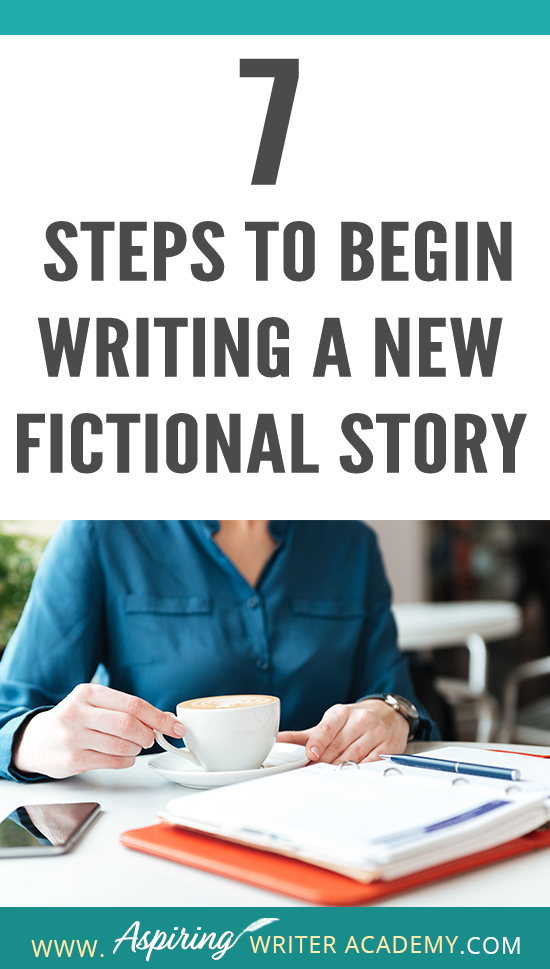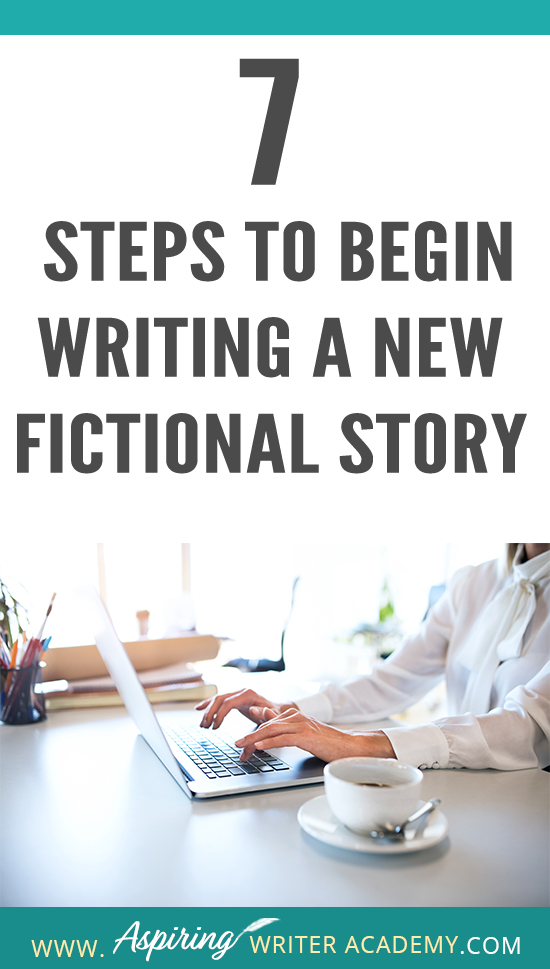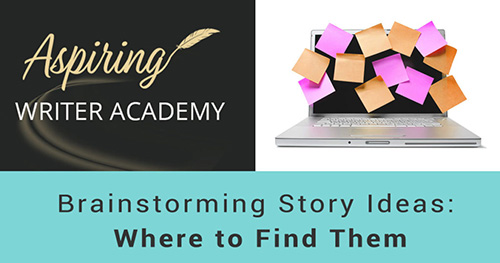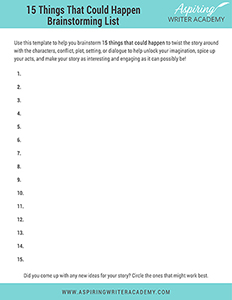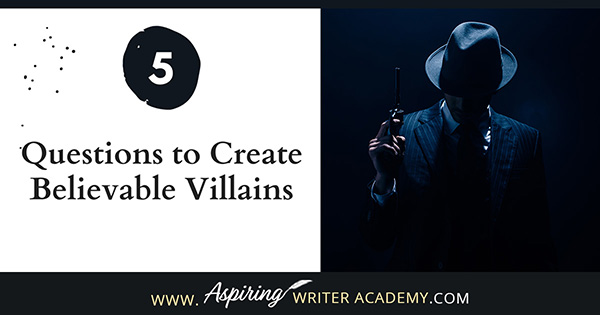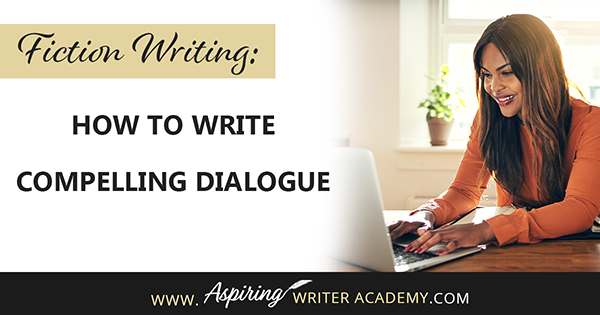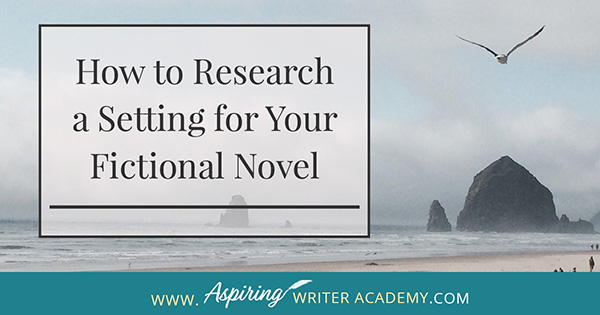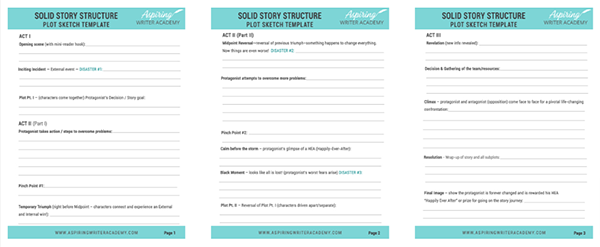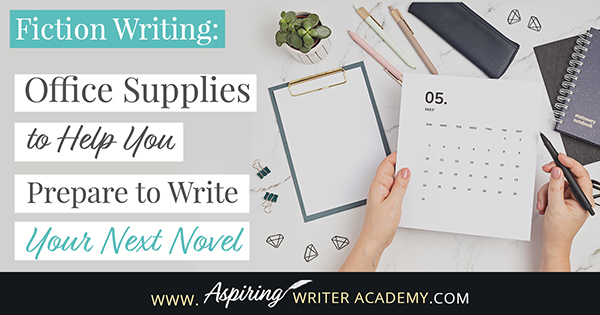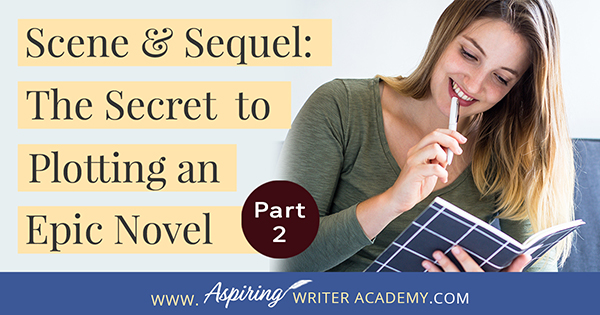7 Steps to Begin Writing a New Fictional Story
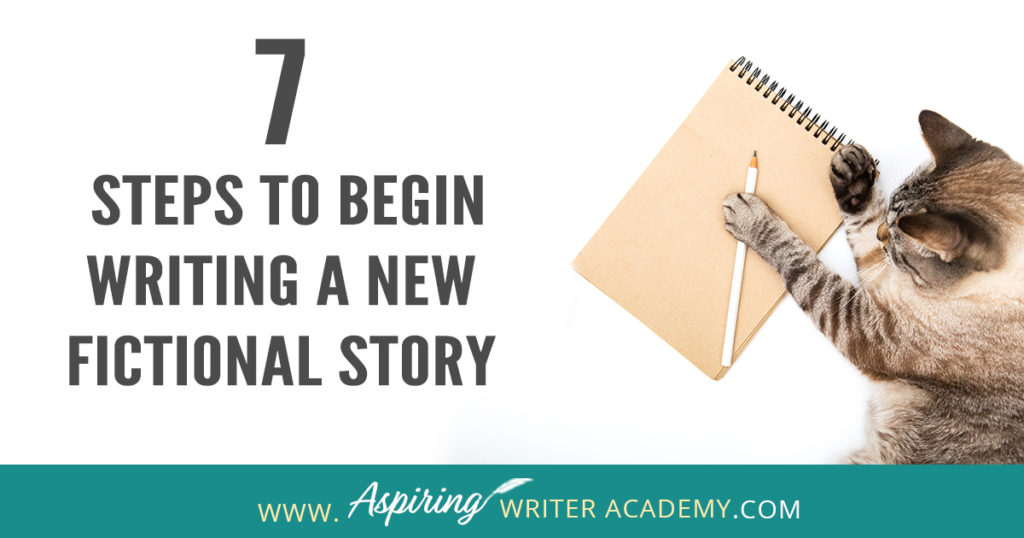
Are you interested in writing a fictional story but do not know where to begin? Do you start with characters, setting, research, or a plot? How do you create deadlines or calculate wordcount? How do you break an idea down into chapters and scenes? How do you set up a working manuscript?
Do you wish you could see how a published author prepares to write a new book? Follow along as we discuss the 7 Steps to Begin Writing a New Fictional Story so you can start writing your own story with ease.
Although various authors all have their own systems for creating a story, and even those systems can change from book to book, I will show you the exact steps I use, my action plan for starting a new manuscript.
1) Brainstorm an Idea
Before you can write a story, you need an idea.
It is always a good idea to continually collect ideas and stick them in a folder. Then when you are ready to write a new story, simply go through the folder and see which idea or group of ideas appeals to you.
How do you find ideas?
Look through newspapers, online articles, magazines, books, TV, movies, online story prompts, jot down bits of interesting conversation you hear in public places or between family members. How could you twist it around to create a story? Look for interesting characters, settings, situations, hard choices.
Also ask yourself: Which locations for setting attract your interest? Is there a specific message or theme you would like to center your story around? What topics or skills do you care about? It helps to write about things you know or would love to research and learn more about. What story genre (romance, sci-fi, horror, historical, etc.) do you want to write?
After you have an initial piece of an idea that you would like to work with, it is time to flesh that idea out further. How could this idea grow in complications to fill the pages of an entire book?
For a solid story idea, your character needs a very dire, action-oriented goal to overcome a specific major problem he/she is presented with at the beginning of the book.
It should take the character many steps to overcome this problem—which becomes the character’s story-worthy goal. This goal takes the whole book to achieve.
- Who is the main character (the protagonist)?
- What does he/she desire or want most? Why?
- Who will actively oppose this character and try to stop him from getting what he wants? (Who is the antagonist or villain?) Why?
- What major, life-altering problem does this opposition character present to the main character at the beginning of the story to get things rolling?
- In response to this game-changing incident, what does the main character decide to do? What story-long goal does the main character need to achieve to overcome this big bad problem by book’s end? Can this larger goal be broken into smaller goal ‘steps’ the character can take in each chapter?
- Where could a story like this take place? (Setting)
- What is the time period, season, or date? Is this a contemporary, historical, or fantasy world?
Download our free comprehensive resource guide with valuable tips and fill-in-the blank templates. Brainstorming Your Story Idea Worksheet.
In simpler terms, you need to answer the traditional story questions:
Who? What? Why? How? When? Where?
Who is this story about?
What do they need to do?
Why do they need to do this?
How will they do it?
When does this need to be completed?
Where does this story take place?
Then, finally:
How does it end? In a nutshell, what is the intended outcome of this story?
Does the main character defeat the antagonist? Does the main character overcome his serious story-worthy problem? Does he achieve his story goal? Does he win or lose at the end, or give up his goal of what he thought he wanted for something better? (Which can still be a win.)
Does the story have an intended message or theme? (If not, the theme may emerge as you write.)
If you get stuck, take your original story idea and brainstorm 15 Things That Could Possibly Happen. You can download our Free Worksheet to help you.
Download the 15 Things That Could Happen Brainstorming List here.
2) Research
Now it’s time to dig deeper and research specific elements of your story either online or through books you might find in the library or bookstore. You might even collect pamphlets and booklets from places you visit, collect maps, diaries, memorabilia. Pinterest and Google are great resources for online research, as well as Wikipedia. What specific details do you need to know about regarding:
- Characters
What do these characters wear in this time period? What do they eat? Do you need to research more information about where they work? Or how they might react in a certain situation? Do you need to research a certain skill the character has or will learn?
Next, you can name your characters and create a cast list. Make sure the names do not conflict with one another in terms of sound and do not have three characters whose names all begin with the same letter. Do you need to research different historical decades to see which names were popular? Do the names have special significance either historically or is the character named after a special person?
- Setting
If this is a real town, what information do you need to include? What is the average weather or temperature for this time of year? What is the terrain? Which buildings or shops are included in this setting? If the setting is fictional, you might need to brainstorm these same questions or research to base the fictional town off of a real town to make it feel real. If it is a historical, the customs of the time period, mode of transportation, as well as a timeline of historical events should be researched.
- Plot (for believability)
Which items or developments in the plot do you need to research? Do you need to find out more about handguns or other weaponry? Or do you need to know how a private investigator operates or how a crime scene is investigated? Or how the heroine might scale a cliff? Do your characters need to know the basics of baking, sewing, archery, or how to milk a cow? Research any areas of the plot that will need accurate details for believability.
- Genre expectations
Research the genre in which you are writing. For example, if you are writing a romance, the audience will expect a HEA (happily-ever-after) ending or they will be sorely disappointed. In a stand-alone mystery novel, it is generally expected that by book’s end, the mystery will be solved.
- Wordcount & Submission Guidelines
Before writing, it would be helpful to research the marketplace or publisher’s guidelines to find the expected wordcount to see how long or short your story should be. Is there a specific style of writing that you should be following?
3) Develop the plot and create a working synopsis
- A synopsis is a story summary. Sketch your story plot from beginning to end using the elements of traditional story structure.
- Insert any notes you may have collected along the way from research or brainstorming.
- The working synopsis can then be expanded as you brainstorm more ideas and become the working manuscript (first rough draft).
Click to download our free Solid Story Structure Plot Sketch Template to help you analyze books or movies, and plot stories of your very own.
4) Calculate your deadline and wordcount
- How long will this story take to complete? If you have a publishing contract deadline, you will have to divide the intended wordcount into the months, weeks, days, allotted and make sure you have ample time to get critique and do revisions. If self-publishing, you may also want to set a deadline to keep your releases on track to satisfy your readers.
- Get out a calendar and set a deadline, then track backwards. How much do you need to accomplish by when? Break it down to weekly wordcounts or tasks. You may also want to schedule your writing time. Schedule blocks or “appointments” into your calendar to work on your writing goals. How many days a week will you write?
5) Create a story binder w/tabbed sections and gather templates and writing supplies
- Each time I start a new story, one of the fun “rewards” I allow myself is to go to the office supply store to pick out a new binder to keep all my new story notes together. I also like to insert double pocket tabbed dividers in my binder. The pockets hold additional notes, and the dividers separate different sections for characters, research, scene snippets, settings, and any other miscellaneous. While some writers like to keep all their writing notes together on programs such as Scrivener, many writers do not want to be online any longer than possible and like the idea of a physical binder.
- I also like to collect a new supply of sticky notes and index cards for plotting, special pens, notebooks, and whatever else I think I may need.
- I also make copies of favorite templates I have collected from classes, courses, conferences that help me to construct a new story with ease. These can be kept in the story binder.
6) Set up a working manuscript document
- Go into your writing program (Microsoft Word or Scrivener, etc.) and create a new document. This makes it official—you are starting to write a new story! Give your working manuscript a temporary name if you do not have a title yet.
Example: Historical Ranch Novella.
- Save the document into its own file on your computer for easy access.
- Set up a header with the working title and insert page numbers.
- Next, center and list chapter headings.
Example:
Chapter 1
Chapter 2
Chapter 3
Chapter 4
Chapter 5
And so on, for as many chapters as you think you might have. You can always add or delete a chapter later while writing, but for now just set up the document.
Now you can take your story summary synopsis and break it up into chapters. (Copy and paste section by section. Or you may want to copy and paste the whole synopsis first, then break it up with the chapter headings.) This becomes your working manuscript. Put all other notes you may have collected into the manuscript
7) Scene & Sequel your scenes/chapters & start writing!
Next, I use the components of Scene & Sequel to plan out my first few scenes within my first few chapters. I usually have about four scenes per chapter. I also evaluate whose POV (point of view) I should use for each of these opening scenes and chapters.
Planning ahead saves a lot of time later and keeps you from going off on irrelevant tangents. I use index cards to chart my Scene & Sequels, or sometimes write the scene & sequel components straight into the manuscript.
Each scene lists the character’s scene goal, the opposition or conflict they encounter, and the resolution or outcome of each scene.
The sequel follows a scene and allows the character to reflect on what just happened in the previous scene and consider what to do next. The specific components of Scene & Sequel drive the story forward to keep your readers on the edge of their seat, whether it is an action-adventure, a romance, or a quieter story of self-discovery.
At last, after you plan your scenes, it’s time to start writing!
Keep to your writing schedule as best you can, learn as you go, and keep forward momentum until you reach ‘The End!’
Recap:
7 Steps to Begin Writing a New Fictional Story
1) Brainstorm an idea
2) Research
3) Develop the plot / synopsis
4) Calculate your deadline
5) Create a story binder
6) Set up a working manuscript
7) Use Scene & Sequel to start writing!
I hope you have enjoyed reading 7 Steps to Begin Writing a New Fictional Story and have gained new insight and valuable tips on how to get started.
If you would like help brainstorming a new story idea, you can download our Free Brainstorming Your Story Idea Worksheet with fill-in-the-blank templates.
Do you find it difficult to create compelling antagonists and villains for your stories? Do your villains feel cartoonish and unbelievable? Do they lack motivation or a specific game plan? Discover the secrets to crafting villains that will stick with your readers long after they finish your story, with our How to Create Antagonists & Villains Workbook.
This 32-page instructional workbook is packed with valuable fill-in-the-blank templates and practical advice to help you create memorable and effective antagonists and villains. Whether you're a seasoned writer or just starting out, this workbook will take your writing to the next level.
If you have any questions or would like to leave a comment below, we would love to hear from you!
Our Goal for Aspiring Writer Academy is to help people learn how to write quality fiction, teach them to publish and promote their work, and to give them the necessary tools to pursue a writing career.

ENTER YOUR EMAIL BELOW
TO GET YOUR FREE
"Brainstorming Your Story Idea Worksheet"
7 easy fill-in-the-blank pages,
+ 2 bonus pages filled with additional story examples.
A valuable tool to develop story plots again and again.
Other Blog Posts You May Like
Fiction Writing: How to Get a Literary Agent
How Writing Prompts Can Improve Your Fictional Story
Creative Writing: 5 Ways to Strengthen a Weak Fictional Character
Fiction Writing: Create a Storyboard to Map Out Your Scenes
Fiction Writing: How Specific Details Can Bring Your Setting to Life
How to Spot Publishing Scams & How To Avoid Them
5 Common Mistakes New Writers Make
Fiction Writing: Story Analysis of the movie “Passengers”
Fiction Writing: How to Write Compelling Dialogue
Fiction Writing: 5 Key Differences Between a Novel and a Novella
Pros & Cons of Traditional vs. Self-Publishing Fiction
3 Ways to Avoid Writing ‘Episodic’ Scenes in Fiction
Scene & Sequel: The Secret to Plotting an Epic Novel
Scene & Sequel: The Secret to Plotting an Epic Novel (Part 2)

is a multi-published author, speaker, and writing coach. She writes sweet contemporary, inspirational, and historical romance and loves teaching aspiring writers how to write quality fiction. Read her inspiring story of how she published her first book and launched a successful writing career.

